
Original author: Joel John and Siddharth
(Part: DAYBREAKER, About Tomo: eth Foundation Illustrator)
“Recommended message: Layer3 has recently launched a intensive exchange and will issue airdrop applications and token pledge on July 30, achieving another phased milestone.The practical application of aggregation theory in the field of cryptocurrency is explained. Taking the Layer3 platform as an example, it introduces how it attracts and retains users by encouraging users to participate in tasks (Quests), and provides users with ownership and economic incentives.enjoy!“
March 2022,
For the first time, I wrote about aggregation theory in the context of cryptocurrency
https://www.decentralised.co/p/on-aggregation-theory-and-web3
Since then, I have witnessed its practical application in several portfolio companies.
-
Hashflow has achieved more than $18 billion in transaction volume.
-
Gem has been acquired by OpenSea.
-
Layer3 has expanded to 4.5 million wallets.
Layer3 is especially special because it was the last payment I checked out from LedgerPrime, just before the FTX crashed.How I wish I could claim that we foresaw these results with a genius foresight, but in fact they were somewhat unexpected.However, in hindsight, it is worthwhile to relive the aggregation theory and explore the scale model available to the founders.
In today’s sharing, we have the honor to work with Layer3, who generously opened up internal datasets for access by VCs and their top users.Over the past few weeks, we have delved into how a business can be a focus point, as Google did in the early 21st century.In today’s column, I will first refute some of my views I made in 2022, and then elaborate on the different strategies that aggregators must adopt in building scale.
We often believe that consumer applications in cryptocurrencies are difficult to scale.However, Layer3, as a product, has 4.5 million wallets that complete 100 million missions.In the process, they have driven nearly 120 million on-chain operations.The scale already exists, but these stories have not been widely circulated or studied in depth.
This issue will take you into the deep understanding of the internal mechanisms of how similar results can be produced.
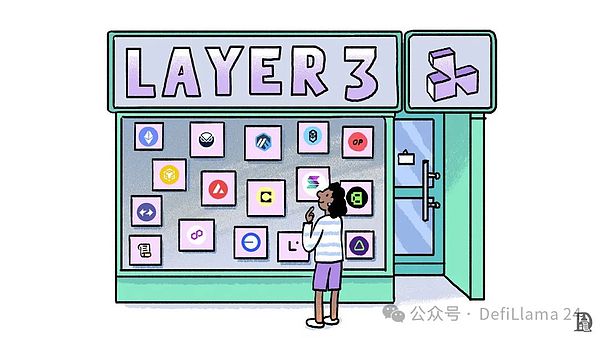
The power of aggregate
Before the advent of the Internet, the most challenging aspect of building any product or service was reaching out to customers.If you want to produce a consumer product, you can only sell it through physical stores.This naturally limits the number of consumers you can reach.The key breakthrough of the Internet lies in its ability to aggregate demand globally.
This aggregation has given birth to many of the world’s most well-known giants today: Google, Netflix, Amazon and Meta, which all follow certain characteristics of aggregation theory to a greater or lesser extent.
There are three key elements of the supply chain: suppliers, distributors and consumers.
-
Vendors: Parties seeking distribution in the network, such as Google and Meta advertisers, Amazon retailers, and Netflix content creators
-
Distributor: The distribution channel of the supplier through this channel to reach end consumers
-
Consumer: The demanding party of the network, the final purchaser of the product or service purchased from the supplier.
Aggregation theory refers to the integration of supply, distribution and demand to optimize processes, reduce costs and improve efficiency.The polymerizer has the following three characteristics:
-
Establish relationships directly with consumers: The platform directly possesses consumers’ time and attention.For example, consumers visit Amazon to purchase items or visit Netflix to consume content.
-
Zero marginal cost of new user services: As more users join the platform, the platform will not incur additional costs.For example, Spotify or Netflix can distribute content to 100 or 1 million users without adding costs (except for service infrastructure).
-
Network effect: Users flock to the aggregation platform, making suppliers more inclined to enter the platform, thereby attracting more users due to the increase in supply.For example, users go to Amazon to buy items, which attracts manufacturers to sell through Amazon, and thus attracts more users due to diversification of supply.
Not all aggregators have every feature.For example, although Amazon is an aggregator, it incurs marginal costs when providing services to each new user.
Ultimately, the aggregator accumulates huge value because it improves the transaction efficiency and user experience of both parties in the market.
Now, let’s turn our attention to the cryptosphere to understand emerging aggregators.Its supply chain is as follows:
-
Supplier: The supplier of cryptocurrencies consists of the first or second layer blockchain and decentralized applications (dApps) with native tokens.The former is designed to distribute block space, while the latter provides products to consumers.These participants are all pursuing efficient allocation strategies to reach and acquire users.
-
Distributor: A distributor is any channel that establishes a direct relationship with consumers.This includes wallets, exchanges, and emerging models that we will discuss further below.
-
Consumers: including developers, institutions or retail participants who have demand for block space or on-chain applications, all belong to consumers.
The market supply side is increasingly fragmented, with hundreds of Layer 1 and Layer 2 blockchains and thousands of dApps emerging.Many of these projects have received tens of millions of dollars in venture capital and hold hundreds of millions of dollars in treasury funds.These assets will be used for promotion as parties compete to reach their target audience.
At a 2019 symposium, Chamath Palihapitiya famously pointed out that for every $1 raised in venture capital,
That’s $0.40 that went to Google, Facebook or Amazon.
We believe that the same dynamic will happen in the crypto space, except that most teams will distribute their native tokens instead of spending cash.Another way to think about TAM is the value of native tokens held in the protocol team’s vault.
As of June 2024, the top 20 blockchain ecosystems jointly held more than $25 billion in token reserves, which are planned to be allocated to users and stakeholders.This value is expected to continue to grow as thousands of projects issue their own tokens over the next few years.
As the market value of these tokens rises, they will become the main tool of incentive mechanisms on the Internet.
We also believe that there are a few applications that have the potential to be the main distribution channel for this expenditure.
This issue focuses on a business that is core to these factors.We interviewed several top users in the study, and they said that Layer3 has become the “Google in the encryption space” for many new users.They bookmark the page as a way to find new products or simply find links they use everyday.In other words, the product has crossed the gap, shifting from the need to retain users to fostering habits in the user base – an achievement that few startups in today’s industry can claim.
Behind these behavioral patterns are some extremely stable business foundations.To understand what these foundations are, we need to go back to early 2022.
Wild Time
Before Luna, 3AC and even the ultimate FTX crash, the industry briefly thought it had crossed the gap.Purchasing the right to naming the gym is regarded as a way to enter the mainstream.However, in terms of user acquisition, the experience is quite fragmented.Although the public has accepted cryptocurrencies, most projects still cannot directly serve ads on Twitter or Google.Product discovery remains largely dependent on Twitter users’ discussions about the product.
New developments in realizing ownership through tokens are emerging in the industry.In the crypto space, tokens actually act as customer acquisition cost (CAC).As the industry evolves, these tokens are used in a variety of ways to attract users.At first, users get it by selling to the community (ICO), then rewarding users by post-event (airdrop), and ultimately attracting users through rewarding capital alignment (liquidity mining).However, these methods have proven to be inefficient.
New distribution channels, such as Layer3, came into being and seek to distribute tokens in a more efficient and optimized way to gain users.This is the area where the “task” platform comes into play.Its value proposition is simple and clear: the brand no longer invests funds in advertising, but directly rewards users.Early adopters looking for new products simply go to the Q&A platform and invest their time.The more products users participate in, the higher the token incentive they receive.
Founded by Layer3
Layer3 was founded in 2021 and was co-founded by Brandon Kumar and Dariya Khojasteh.Remember, Layer3’s initial login page reads “Earn cryptocurrency by doing trivia.”Its core philosophy is to create a market where protocols use their tokens to coordinate user behavior.Interestingly, the two of them successfully raised seed funding through the help of two websites built by Webflow and Airtable.
The platform has grown into one of the fastest growing aggregators in the industry.Supporting this growth is a technology stack that can solve the pain points in user identification, distribution, and user asset ownership.
Prior to joining Layer3, Brandon was an investor at Accolade Partners, an institution that manages billions of dollars in assets and one of the largest capital allocators in the global venture capital (VC) and private equity (PE).His extensive experience as an investor allows him to manage the supply side of his business well.He builds relationships with protocol builders and cross-sells across dozens of VC-backed portfolios, ensuring the strength of the network supply side.Of course, this requires a world-class product, and that’s where Dariya’s expertise lies.
Daria, an experienced app developer, has successfully built and expanded multiple consumer applications.He is fully capable of designing the Layer3 product experience that is now well-known.The well-thought-out gamification and effective user experience strategies he implemented brings a highly engaging and addictive consumer experience.
Essentially, Brandon focuses on the B2B end of the business, responsible for the access to the protocol, while Dariya focuses on the B2C end and is committed to interacting with consumers.This complementary way of working is a key factor in Layer3 becoming a leading aggregation platform.
Solve cold start problem
In the early stages of Layer3, there was a classic “Chicken first or egg first” problem.Only when the task platform reaches a certain scale can it have pricing power.Just like the aggregators in the traditional world, the value you can control depends on the resources you have on the demand side.Amazon is able to negotiate with suppliers for a better price because it has a large user base.
But how to deal with it when you don’t have users?How do you stand out in an area where multiple existing businesses compete?This is the challenge Layer3 faced in the early stages.They know that they will find it difficult to master pricing power until they have a large number of users.Therefore, most of their early energy was focused on cultivating core believers.
Layer3’s earliest tasks focused on the newly launched protocols—the applications in these protocols are still in their infancy, and users explore them out of pure curiosity.
Layer3’s initial mission is to discover and present new products before market discovery.The focus is on selecting rather than profit.Users quickly began to flock to the product because they knew it was a reliable source for finding cool activities on the chain.This is similar to a similar paradigm that emerged in the development of networks in the early 21st century.
As users go online one after another, Google has gradually become the homepage of many users.
Why?Because remembering the website is troublesome.
You can go directly to Google and enter a query like “Face Book” to find this social network.During the research of this article, we met several users whose main purpose of using Layer3 is to discover new protocols in a safe and pleasant way.
One strategy that Layer3 used early on was to run tasks for a specific protocol before it was exposed to a specific protocol for sale.Often, this leads founders to notice a significant increase in user traffic from third-party products, thus tending to work with Layer3.
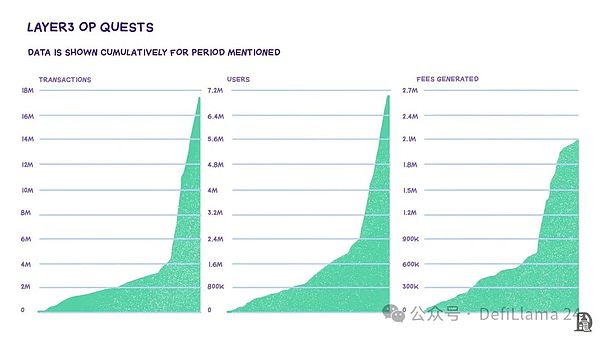
Optimism chain dedicated data
At the time of writing, Layer3 has become one of the most commonly used applications on Arbitrum, Base, and Optimism.
As of June 29, 2023, they have assisted with more than 120 million on-chain operations with users from 120 countries, and nearly 4.5 million wallets have interacted with the product.Today, Layer3 has driven the growth of 31 different blockchains and more than 500 protocols in the gaming, AI, DeFi and NFT fields.
According to the team, they receive active attention from 60 to 90 protocols per month that are interested in joining their distribution network.
As mentioned above, there is no need for the supply side of the network to attract the supply side.Now, let’s focus on user behavior and the relationship between Layer3 and end consumers.
Aggregation requirements
Layer3’s significant growth and user engagement are not achieved overnight.In 2022, although the company raised much lower than its peers, its well-thought gamification strategy allowed it to expand rapidly.
A lot of reference to the Octalysis framework
https://yukaichiu.com/gamification-examples/octalysis-complete-gamification-framework/
, Layer3’s platform has become a benchmark for building an industry-leading consumer experience.
The Octalysis framework developed by Zhou Yukai breaks down the complexity of gamification into eight core drivers that inspire human behavior.It forms the basis for the Layer3 team to think about its products.
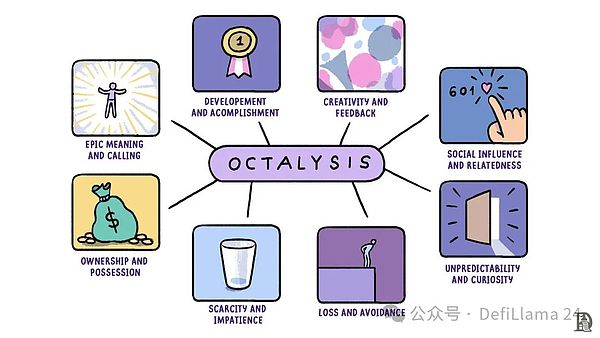
First of all, Layer3 satisfies users’ pursuit of grand meaning and sense of mission by allowing users to gain ownership in agreements and projects.This gives users a sense of contributing to their careers beyond themselves.The platform satisfies users’ desire for growth and achievement through XP system and reward centers. Users accumulate experience values by completing activation tasks (such as tasks, competitions, and combos), thereby staying competitive and unlocking more opportunities.
By strategically using gemstones within the platform store, users’ creativity and strategic planning will be stimulated to meet the needs of creativity and feedback.Ownership and sense of ownership are the key points, and Layer3 ensures users have a strong sense of belonging to their digital assets and identities through CUBEs and ERC-20 tokens.More details will be revealed later.
This sense of ownership deepens user engagement and loyalty.

Layer3 rankings.In the process of writing this article, we talked with several leading users of the platform to understand their views on the platform.
Social influence and relevance are utilized through the ranking function, which displays top users and creates a competitive environment where users work hard to improve their rankings and gain recognition.Scarcity and urgency are created by implementing tasks, competitions, and limiting season durations of time or number of participants, and inspiring users to act quickly to gain profits.
Layer3 also uses unpredictability and curiosity to attract users to continue to interact with the platform and explore possible unlocked rewards.Finally, through the daily winning streak function, users’ driving force for losses and avoidance is met, and they are encouraged to return to the platform regularly to avoid losing progress.
Some senior users of the platform have been using the product for more than two and a half years because they are worried about losing their lead.
Google in the cryptocurrency space
When the network first appeared, its monetization potential was unclear.Analysts in the late 1990s had speculated that a person would see Microsoft loading a page in order to assess the possibility of advertising on that page.People’s attention is turning to digital, but mechanisms to measure their value have not been established.As a large number of users began to focus on a few platforms, solutions emerged.
Google, Facebook and Amazon have built huge data silos that can predict user emotions, preferences, and curiosity.
These datasets are isolated and are not open to developers for utilization and targeting users.Advertising on the Internet is like tax paid to the platform to reach users.The longer a user stays on Facebook, the higher the probability that Facebook will show ads to them.And the more advertisements they see, the greater the possibility of purchasing.Facebook has the motivation to immerse users in it for a long time, because its revenue depends on it.
Between 2010 and 2020, the Internet has evolved into an attention trap, keeping us staring at the screen
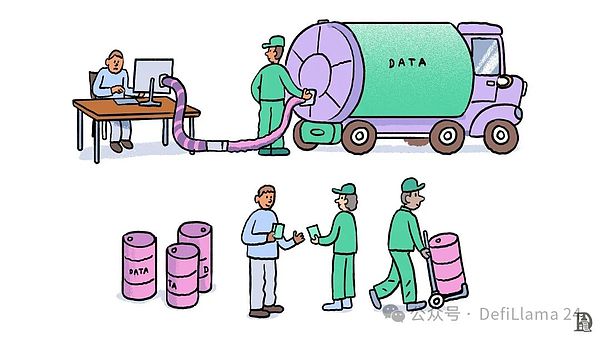
Blockchain acts as a funding track, allowing advertisers to directly reward users.
Incentive mechanisms often explain why systems work so.We share the most private details on products like Meta’s Instagram, WhatsApp or Facebook.In the mid-2010s, we checked in restaurants, shared photos, and recorded our emotional state in detail.
We haven’t noticed that while the platform encourages us to give up on data, we are not fully aware of the process.
As mobile devices become increasingly powerful, the network no longer requires us to log in to their products.We gave up on our data through Google search, GPS targeting, and sometimes even through chat.
Layer3 subverts this mode in two powerful ways.
User-owned data
Unlike traditional advertising models, consumers on Layer3 have their own data through CUBEs.These credentials are portable and permanently held by the user.Once issued, Layer3 cannot be recovered.CUBEs are ERC-721 tokens received by users after Layer3 is activated.Each token contains custom metadata, unifying the user’s on-chain session data.This enables users to have their own on-chain footprint and helps the protocol to target target users more accurately.
According to Growthepie.xyz (as of June 17, 2024), CUBEs has become the most popular NFT on the Base, Optimism, Arbitrum and zkSync platforms, with more than 1.5 million wallets that have Cube NFTs across chains.

Cubes are on-chain credentials that grant users the qualification to perform specific actions.
Consumer positive unit economics
In addition to owning their own data, users actually gain ownership of the agreement they use through Layer3.For example, if consumers complete an Optimism activation on Layer3, they will receive OP tokens.If they complete Arbitrum activation on Layer3, they will get ARB tokens.This process is facilitated by Layer3’s distribution protocol, which rewards users dynamically based on their on-chain footprints.
We will discuss this particular dynamic in the next section.
The result is a strong moat around consumer adoption and attention, allowing Layer3 to build a large audience and allow them to access more protocols to reach a wider audience.
A few years ago, Jesse Walden published an article titled “
Ownership Economy
https://variant.fund/articles/the-ownership-economy-crypto-and-consumer-software/
blog post.The basic premise is that as individuals’ contribution to platform value creation becomes increasingly common, the next evolution direction is to develop towards software built, operated, funded and owned by users.This ownership is achieved through tokens.
We firmly believe in this future, but acknowledge that this vision has not yet been realized due to the lack of good infrastructure for efficient ownership allocations until recently.Mechanisms such as airdrop and liquidity mining have tried to solve this problem, but overall they have performed poorly.
One of the core value propositions Layer3 provides to the protocol is to provide a more efficient way to distribute tokens to acquire users.The protocol routes tokens through Layer3 to reach the right users at the right time.
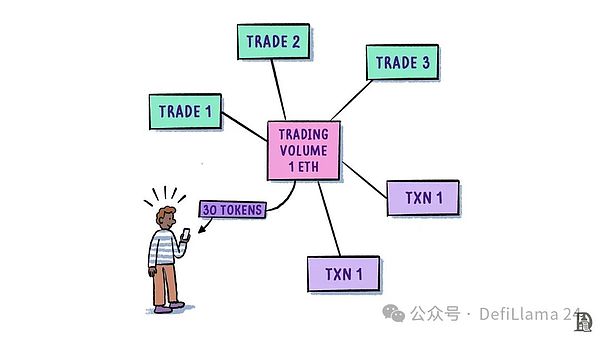
The milestone mechanism allows developers to require users to complete a series of operations within a period of time before they can receive rewards.
Further, last month, Layer3 launched a product called “Milestone”.This product observes the user’s behavior over time, and rewards the user not a single transaction, but a combination of multiple activities.For example, users may need to lock funds in a smart contract for 30 days, or complete five transactions on Uniswap within a month.
Unlike traditional airdrop models that focus on single events or cumulative transactions, Layer3’s Milestone product enables developers to mix and match on-chain interactions that drive value.
For me, this highlights the main differences between scale businesses and crypto businesses in Web2.Unlike Google or Meta, Layer3 has little monopoly on its user data.As mentioned before, anyone can query it.They don’t even monopolize the way users get value.Anyone can query CUBE holders and send them tokens.Layer3 accumulates value in two key ways:
-
Long-term relationship with users: The past transaction records cannot be forged on the blockchain.Layer3 uses tasks on its platform to filter out users with years of transaction data, which creates a significant moat.
-
Featured Best Products: Their ability to screen out the best products comes from their huge user base.In the early days, they needed to actively look for products, but now products are actively coming.In multiple user interviews we conducted, users often mention trust in Layer3 as a product discovery engine.As of writing, Layer3 has partnered with nearly 500 different products.
Users benefit a lot from this model.
In the Web2 advertising model, users benefit little from the products they are pushed in large quantities.They spend their scarce resources—time—that hopefully find relevant content.Layer3’s rules are completely opposite.Competitive competition among products regarding token rewards received by users’ attention.The higher the user’s value, the richer the reward.
This kind of user competition also exists in Web2, but most of its value is captured by platforms such as Google, rather than end users.
By contrast, Layer3 passes most of the value to the end user.You might ask, “How is Layer3 different from its peers?” Remember I mentioned before, does aggregation theory in the field of crypto need a community?This is the key element.In products that form large communities, users’ continued return visits are partly due to their loyalty to the community and their relative position in the community.This translates into long-term, timestamp proof of user activity on the chain.
Of course, you can find millions of wallets with active records using tools like Etherscan.But to find a filtered user list that provides timestamps to prove that they are early participants in new products and have a single website that allows them to find you, that requires a platform.And this is exactly what Layer3 is currently positioning.
While researching this post, I stumbled upon a blog written by one of the founders of Layer3.Dariya posted a post on his personal website titled
“I’m just paying attention”
In a paragraph near the end of his article, he elaborates on the reasons for the Layer3 moat.
Pay attention, coordination and distribution are related to each other.Can you reach the crowd?Can you let people do something beneficial for your ecosystem?Through several metaphors, we can deepen our understanding: attention is oil, distribution is kerosene, and coordination is oil.On the Internet, value usually accumulates only on the platforms that bring your attention.
But in Layer3, we aim to disrupt this.You own the network and you accumulate value.The project issues value directly or indirectly to you, as evidenced by Layer3 users capturing 20.4% of the entire Arbitrum airdrop.Moreover, in the past sixty days, more than 20 projects have directly issued incentives through agreements.
In other words, Layer3 is able to capture value while disrupting the historical relationship between advertising networks and products.To me, that’s the definition of a disruptor.
Moat, Values and Habits
In my years of writing career, I knew that encryption technology would evolve into a value network.The core function of blockchain is to promote value transfer.Its main application scenario is transactions worldwide.Layer3 serves nearly 120 countries and covers 4.5 million wallets, the closest I’ve ever seen to a fully functional and scalable “value transfer network”.
As the network continues to evolve, advertising was a necessary means to access billions of users on the Internet.But now, we have surpassed that stage.The user is in place.Now, what we need is a better way to monetize and position.Layer3 is just at the critical point of this transformation – moving from attention network to value network.We are moving from an era where users give their time and data to an era where they own data and gain economic value.
If users are able to receive value (in tokens or NFT minted), the platform will inevitably compete to provide the best rewards.This is where the Layer3 business model has a strong moat.
With the number of people using its products today, Layer3 will be able to continuously guide and build user incentives.Large protocols like Uniswap may not have the motivation to work with a new Q&A platform with less than 100,000 users.But what if you could target five million wallets?
In terms of scale, this is equivalent to the size of the entire DeFi market in 2021.This is where Layer3 is positioned.Compared to this, it was like being on the homepage of Google Play or Steam in early 2012.
This will change the way developers think about application releases.Products launched in the crypto space often face cold start problems – finding the initial sticky user base to collect data is extremely difficult.Traditionally, the product will work with well-known networks like Polygon or Solana to solve this problem.However, as platforms such as Layer3 provide distribution services from day one, their dependence on the network has been greatly reduced.
Developers can launch a campaign through Layer3 to find core user groups and reward them as early adopters.In my opinion, it’s like the Google Ad Manager moment in the crypto space—a key node where developers realize that they can effectively invest resources on platforms that provide meaningful targeting, rather than relying solely on KOLs.
Of course, this positioning also brings its advantages.Layer3’s operating scale means they can expand into their own product range.They can integrate with exchanges and see hundreds of millions of dollars flow back and forth as users exchange tokens within their products.They can even launch their own exchanges or launch platforms.

Layer3 data shared by investors.The data shows the number of transactions made between users using Layer3 and users not using Layer3 over a specific time period.Observations found that Layer3 users are more active in various time periods.
Attention precedes mobility.Layer3 has significantly gathered the former.The more transactions users make within their ecosystem, the greater the surface area they will increase the user’s lifetime value.The natural extension is to expand to the vertical areas where users express their needs.For example, Jupiter charges 1% of the token supply to launch a new token.
What prevented Layer3 from adopting the same strategy?This will create a flywheel effect, with users flocking to the product, hoping to become early participants in the new project, which will also use Layer3 to help scale.
Around 2003, Google decided not to index web pages anymore.Over the next five years, they conducted an IPO, launched GMail, acquired YouTube, and bought Android.These initiatives laid the foundation for the Internet as we know it today.Google takes these actions because they realize that more and more attention is shifting online and waiting to be monetized.Google has successfully discovered these acquisition opportunities by identifying the direction of demand.This is the advantage brought by positioning.
Layer3 is also in a good position.They are motivated to expand into new areas because it is obvious that users can see where they invest the most time and resources.Although blockchain data is public and can be viewed by anyone, not everyone can activate the same user group because they lack the direct connection between Layer3 and users.
Layer3 has the distribution requirements to launch a new product line and expand to value.The only thing that is lacking is time and the compound interest effect that comes with it.
When we met Brandon at TOKEN2049 in Dubai, one of the topics we discussed was which of today’s many agreements will last until the next decade.This perspective reflects how Brandon and Dariya think about their business.Most founders are worried about the token price in the next quarter; while they are working on a decade-long layout.
This does not mean that there is a smooth road ahead of Layer3.Building a value network requires developers to accept a model of token incentives for use—an established but not yet popular business model.As other consumer areas such as AI attract public attention, the on-chain user market may shrink, or the total number of agreements willing to work with Layer3 may reach saturation.
All of these are real challenges.But if Layer3’s operations over the past two years show what it means, I bet Brandon and Daria will continue to exist for the next decade, continuing to realize their vision of tokenizing attention.








